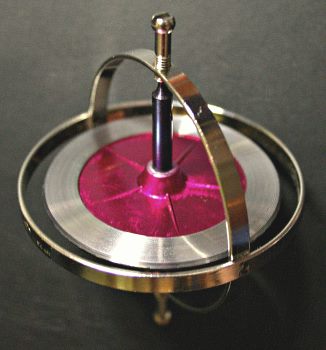property>moment of inertia
What is Moment of Inertia?

Moment of inertia, also known as rotational inertia, is analogous to the inertia of linear motion. It is necessary to specify a moment of inertia with respect to an axis of rotation. According to Newton's first law of motion "A body maintains the current state of motion unless acted upon some external force". The moment of inertia is related to the distribution of mass throughout the body, not just mass of the body alone. That is why two bodies of the same mass may have different moments of inertia.
If we consider a rigid body as a system of particles and the relative position of these particles does not change, then the moment of inertia of a point mass is equal to: I = m.r 2, for each particle so that the moment of inertia is equal to the mass multiplied by the square of the distance, where m = the mass of the particle, and r = the distance from the axis of rotation to the particle. Moment of inertia is also referred to as the second mass moment. The first mass moment is equal to mass multiplied by distance, m.r. The centre of mass of a system of particles or a rigid body can be derived using the first moment concept.
The moment of inertia of an object is a measure of how difficult it is to change the angular motion of that object about the axis. For example we can take two discs of equal mass but the diameter of one is greater than the other. As a result its mass would be distributed further from the axis of rotation and it would take more effort to accelerate the first disc as compared to the second. This is because the first disk has a larger moment of inertia.
If the shape of object changes so would the moment of inertia of that object. When a skater pulls in her oustretched arms her rotation speeds up because her moment of inertia is reduced and consequently the angular momentum increases. This inertia is also responsible for the stability of a gyroscope.
Rotational Kinetic Energy
The rotational kinetic energy of a body can be expressed in terms of its moment of inertia. Given masses m moving with speeds v, the rotational energy T for each is mass T=1/2mv 2=1/2m(wr) 2=1/2mr2w2=1/2Iw 2 where w is the angular velocity When the angular momentum vector is parallel to the angular velocity vector, they can be related using the equation L=wIwhere the angular momentum is L andthe angular velocity ω. If the moment of inertia is constant the torque on an object and its angular acceleration are related by T= I αWhere t is the torque and α is the angular acceleration.
Parallel Axis Theorem
Once the moment of inertia has been calculated for rotation about the centre of mass of a rigid body, the moment of inertia for any parallel rotation axes can be calulated as well, without needing to go back to the formal definition. If the axis of rotation is displaced by a distance R from the centre of mass axis of rotation (e.g. a disc being spun around a point near its edge rather than the centre) the displaced and centre-moment of inertia are related as follows: We can calculate the moment of inertia for parallel rotation axes easily once we have calculated the moment of inertia for rotations about centre of mass. If the axis of rotation is a distance R from the centre of mass, then we get the following equation. I(displaced) = I(centre) + M.R2
Formulae for Moment of Inertia
Thin cylindrical shell with open ends, of radius r and mass m: I = m.r2
Thick-walled cylindrical tube with open ends, of inner radius r1, outer radius r2 and mass m : I = 1/2m.(r12+r22)
Solid cylinder of radius r and mass m : I = m.r2/2
Thin, solid disk of radius r and mass m : I = m.r2/2
Thin circular hoop of radius r and mass m: I = m.r2
Solid sphere of radius r and mass m: I = 2m.r2/5